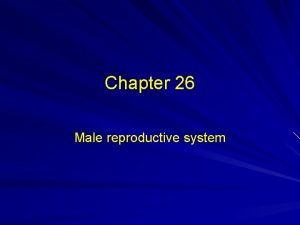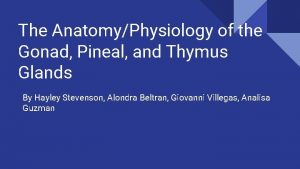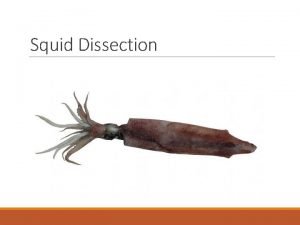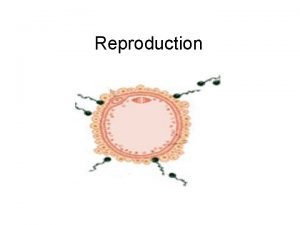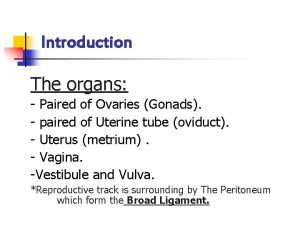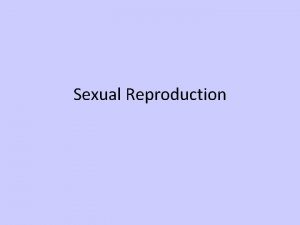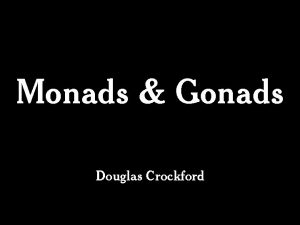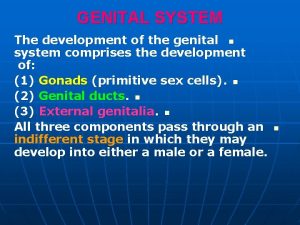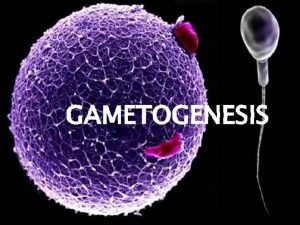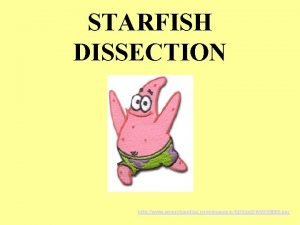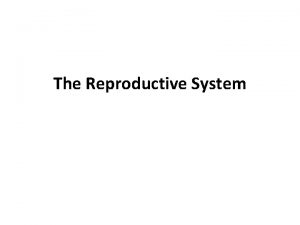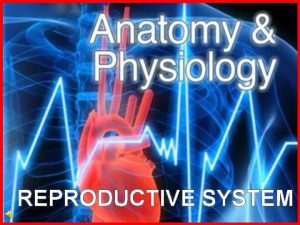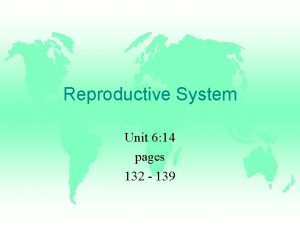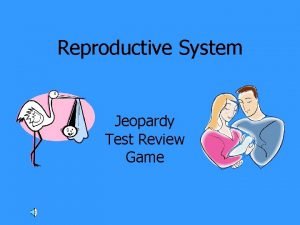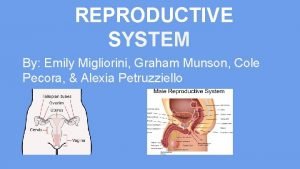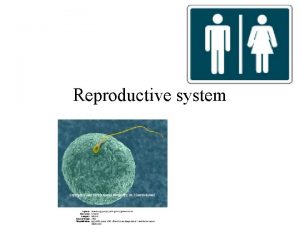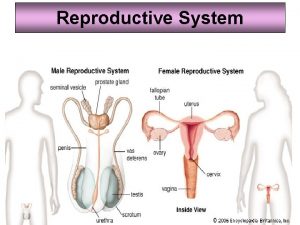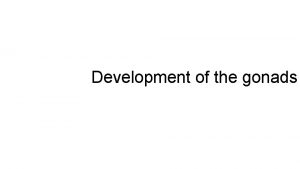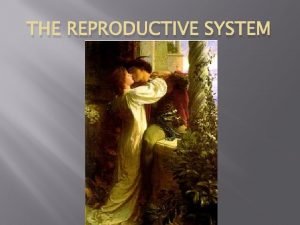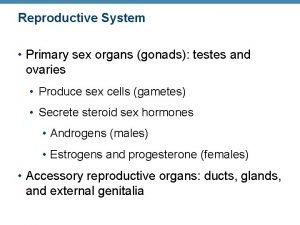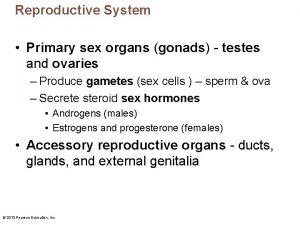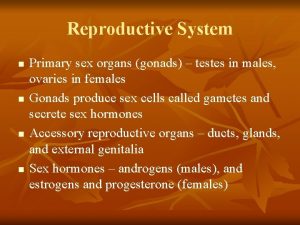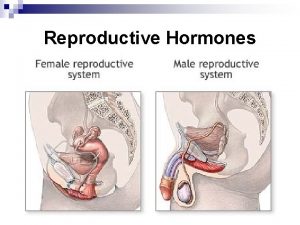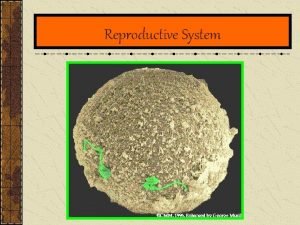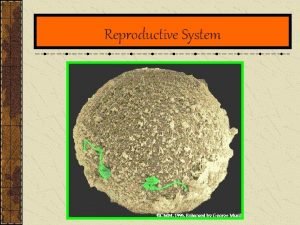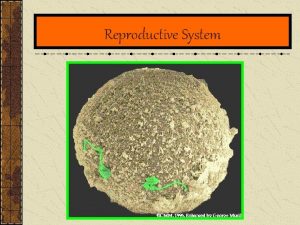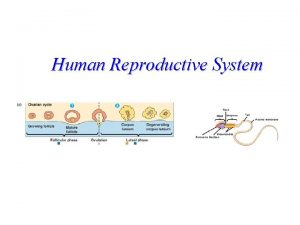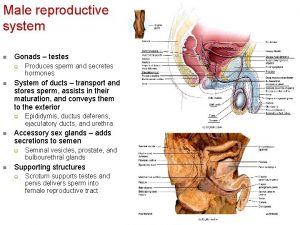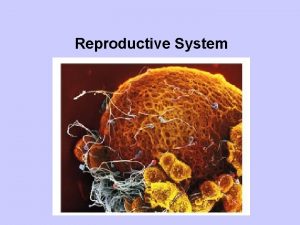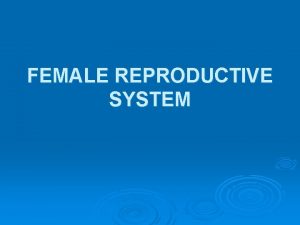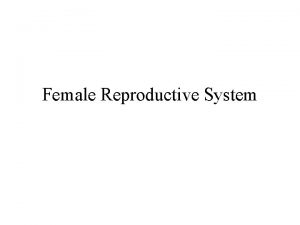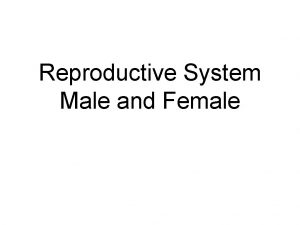The Reproductive System The Reproductive System Gonads primary








































































- Slides: 72

The Reproductive System

The Reproductive System · Gonads – primary sex organs · Testes in males · Ovaries in females · Gonads produce gametes (sex cells) and secrete hormones · Sperm – male gametes · Ova (eggs) – female gametes


Male Reproductive System · Penis · Testes · Scrotum · Prostate · Duct system · Epididymis · Vas deferens · Urethra

Penis · Function: sex organ used to deliver sperm and excrete urine · Several components: · Glans penis (head)- may be covered with mucosa if uncircumcised · Corpus cavernosum- tissue running along the sides of the penis · Fills with blood to cause an erection · Corpus spongiosum- column of sponge-like tissue running along the front of the penis · Fills with blood to cause an erection


Testes · Function: to produce sperm androgen hormones (primary testosterone) · Found within the scrotum · Made up of dense connective tissue containing hundreds of lobules · Tightly coiled structures · Function as sperm-forming factories · Interstitial cells produce androgens such as testosterone Copyright © 2003 Pearson Education, Inc. publishing as Benjamin Cummings Slide 16. 4

Testes · Coverings of the testes · Tunica albuginea – capsule that surrounds each testis · Septa – extensions of the capsule that extend into the testis and divide it into lobules Copyright © 2003 Pearson Education, Inc. publishing as Benjamin Cummings Figure 16. 1

Vas Deferens · Function: Carries sperm from the epididymis to the ejaculatory duct · Passes through the inguinal canal and over the bladder · Moves sperm by peristalsis · Spermatic cord – ductus deferens, blood vessels, and nerves in a connective tissue sheath · Ends in the ejaculatory duct which unites with the urethra

Vas Deferens · Vasectomy – cutting of the ductus deferens at the level of the testes to prevent transportation of sperm

Epididymis · Function: to mature and store sperm cells (at least 20 days) · Expels sperm with the contraction of muscles in the epididymis walls to the vas deferens · Comma-shaped, tightly coiled tube · Found on the superior part of the testis and along the posterior lateral side Copyright © 2003 Pearson Education, Inc. publishing as Benjamin Cummings Slide 16. 5

Scrotum · Function: to house the testes, epididymis, nerves, and blood vessels · Acts as a climate control system for sperm to develop · Contains many sebaceous and sweat glands Copyright © 2003 Pearson Education, Inc. publishing as Benjamin Cummings Slide 16. 5

Prostate Gland · Function: Secretes a milky fluid · Helps to activate, nourish, and protect sperm · Enters the urethra through several small ducts · Encircles the upper part of the urethra

Urethra · Function: Carries both urine and sperm · Sperm enters from the ejaculatory duct · Extends from the base of the urinary bladder to the tip of the penis

Urethra · Regions of the urethra · Prostatic urethra –surrounded by prostate · Membranous urethra – from prostatic urethra to penis · Spongy (penile) urethra – runs the length of the penis

Bulbourethral Glands · Pea-sized gland inferior to the prostate · Produces a thick, clear mucus · Cleanses the urethra of acidic urine · Serves as a lubricant during sexual intercourse · Secreted into the penile urethra

Male Reproductive System Copyright © 2003 Pearson Education, Inc. publishing as Benjamin Cummings

Secondary Sex Characteristics · Body hair (chest, underarms, facial, pubic) · Deepening of voice due to enlargement of Adam’s apple (larynx) · Increased musculature · Increased height

Processes of Spermatogenesis · Spermatogonia (stem cells) undergo rapid mitosis to produce more stem cells before puberty · Follicle stimulating hormone (FSH) modifies spermatogonia division · One cell produced is a stem cell · The other cell produced becomes a primary spermatocyte

Processes of Spermatogenesis · Primary spermatocytes undergo meiosis · Haploid spermatids are produced

Processes of Spermatogenesis · Spermiogenesis · Late spermatids are produced with distinct regions · Head – contains DNA covered by the acrosome · Midpiece · Tail · Sperm cells result after maturing of spermatids · Live up to 5 hours outside the body · Spermatogenesis takes 64 to 72 days

Female Reproductive System · Vagina · Cervix · Ovaries · Duct System · Fallopian tubes · Uterus · Labia · Clitoris · Hymen Copyright © 2003 Pearson Education, Inc. publishing as Benjamin Cummings Slide

Vagina · Function: Serves as the birth canal · Receives the penis during sexual intercourse · Extends from cervix to exterior of body · Behind bladder and in front of rectum

Cervix · Function: Allows flow of menstrual blood from uterus, directs sperm from vagina, and is the opening from which a fetus will exit the uterus · Made up of strong muscles · Very narrow (1 -2 cm)

Uterus · Functions: · Receives a fertilized egg · Retains the fertilized egg · Nourishes the fertilized egg · Tissue sloughs off during menstruation · Located between the urinary bladder and rectum · Hollow organ

Walls of the Uterus · Endometrium · Inner layer · Allows for implantation of a fertilized egg · Sloughs off if no pregnancy occurs (menses) · Myometrium – middle layer of smooth muscle · Serous layer – outer visceral peritoneum


Regions of the Uterus · Body – main portion · Fundus – area where uterine tube enters · Cervix – narrow outlet that protrudes into the vagina

Support for the Uterus · Broad ligament – attached to the pelvis · Round ligament – anchored interiorly · Uterosacral ligaments – anchored posteriorly

Support for the Uterus Copyright © 2003 Pearson Education, Inc. publishing as Benjamin Cummings

Uterine (Fallopian) Tubes · Function: · Receive the ovulated oocyte · Provide a site for fertilization · Attaches to the uterus · Does not physically attach to the ovary · Supported by the broad ligament

Uterine Tube · Fimbriae – finger-like projections at the distal end that receive the oocyte · Cilia inside the uterine tube slowly move the oocyte towards the uterus (takes 3– 4 days) · Fertilization occurs inside the uterine tube

Ovaries · Function: · Produce oocytes (eggs) for fertilization · Manufacture hormones progesterone and estrogen · Release eggs into fallopian tube

Ovaries · Composed of ovarian follicles (sac-like structures) Figure 16. 7

Labia ·Function: provide protection for female sex and urinary openings ·Three portions: ·Mons pubis- fat tissue found in front of the pubis symphysis ·Labia majora- rounded folds of skin and fat forming the vulva ·Labia minora- thin cutaneous folds forming vulva

Clitoris ·Protruding tissue located above the vaginal opening that is stimulated for orgasm

Hymen ·Function: small area of connective tissue that partially closes the vagina until it is ruptured

Female Reproductive System Copyright © 2003 Pearson Education, Inc. publishing as Benjamin Cummings

Secondary Sex Characteristics ·Wider hips ·Developed breasts ·Increased height ·Increased fat in thighs and buttocks ·Body hair (legs, underarms, pubic) Copyright © 2003 Pearson Education, Inc. publishing as Benjamin Cummings

Ovarian Follicle Stages · Primary follicle – contains an immature oocyte · Graafian (vesicular) follicle – growing follicle with a maturing oocyte · Ovulation – when the egg is mature the follicle ruptures · Occurs about every 28 days · The ruptured follicle is transformed into a corpus luteum

Oogenesis · The total supply of eggs are present at birth · Ability to release eggs begins at puberty · Reproductive ability ends at menopause · Oocytes are matured in developing ovarian follicles

Oogenesis · Oogonia – female stem cells found in a developing fetus · Oogonia undergo mitosis to produce primary oocytes · Primary oocytes are surrounded by cells that form primary follicles in the ovary · Oogonia no longer exist by the time of birth

Oogenesis · Primary oocytes are inactive until puberty · Follicle stimulating hormone (FSH) causes some primary follicles to mature · Meiosis starts inside maturing follicle · Produces a secondary oocyte and the first polar body · Meiosis is completed after ovulation only if sperm penetrates · Two additional polar bodies are produced

Oogenesis Copyright © 2003 Pearson Education, Inc. publishing as Benjamin Cummings

Menstrual (Uterine) Cycle · Cyclic changes of the endometrium (uterine tissue) · Regulated by cyclic production of estrogens and progesterone · Estrogen- hormone responsible for secondary sex characteristics, lactation, bone formation · Peaks during ovulation · Produced by follicle cells · Progesterone- hormone responsible for thickening the uterine wall to prepare for fertilization and maintain pregnancy · Peaks after ovulation · Produced by corpus luteum

Menstrual (Uterine) Cycle ·Stages of the menstrual cycle ·Menses – functional layer of the endometrium is sloughed · 1 -5 days (Period) · 10 -80 ml blood loss ·Proliferative stage – regeneration of functional layer (5 -14 days) ·Estrogen levels are high, stimulating release of FSH and LH ·Follicle stimulating hormone encourages egg to be released ·Lutenizing hormone encourages development of corpus luteum

Menstrual (Uterine) Cycle ·Secretory stage – endometrium increases in size and readies for implantation · 14 -28 days ·Progesterone is released in response to LH and FSH ·During this time, egg must be fertilized or the cycle begins again

Hormonal Control of the Ovarian and Uterine Cycles Copyright © 2003 Pearson Education, Inc. publishing as Benjamin Cummings

Hormonal Control of the Ovarian and Uterine Cycles Copyright © 2003 Pearson Education, Inc. publishing as Benjamin Cummings

Stages of Pregnancy and Development · Fertilization · Embryonic development · Fetal development · Childbirth

Mechanisms of Fertilization · Fertilization occurs when the genetic material of a sperm combines with that of an oocyte to form a zygote · Membrane receptors on an oocyte pulls in the head of the first sperm cell to make contact · The membrane of the oocyte does not permit a second sperm head to enter · The oocyte then undergoes its second meiotic division

Fertilization · The oocyte is viable for 12 to 24 hours after ovulation · After proliferation phase, beginning of secretory phase of menstruation · Sperm are viable for 12 to 48 hours after ejaculation · Average ejaculation has 100 million sperm · Sperm cells must make their way to the uterine tube for fertilization to be possible

Development from Ovulation to Implantation Copyright © 2003 Pearson Education, Inc. publishing as Benjamin Cummings

The Zygote · First cell of a new individual · The result of the fusion of DNA from sperm and egg · The zygote begins rapid mitotic cell divisions · The zygote stage is in the uterine tube, moving toward the uterus

The Embryo · Developmental stage from the start of cleavage until the ninth week · The embryo first undergoes division without growth · The embryo enters the uterus at the 16 -cell state · The embryo floats free in the uterus temporarily · Will attach onto endometrium wall · Uterine secretions are used for nourishment

The Blastocyst · Ball-like circle of cells · Begins at about the 100 cell stage · Secretes human chorionic gonadotropin (h. CG) to produce the corpus luteum to continue producing hormones · The blastocyst implants in the wall of the uterus (by day 14)

Development After Implantation · Chorionic villi (projections of the blastocyst) develop · Cooperate with cells of the uterus to form the placenta · The embryo is surrounded by the amnion (a fluid filled sac) · An umbilical cord forms to attach the embryo to the placenta

Development After Implantation Copyright © 2003 Pearson Education, Inc. publishing as Benjamin Cummings

Development from Ovulation to Implantation Copyright © 2003 Pearson Education, Inc. publishing as Benjamin Cummings

Functions of the Placenta · Forms a barrier between mother and embryo (blood is not exchanged) · Delivers nutrients and oxygen · Removes waste from embryonic blood · Becomes an endocrine organ (produces hormones) and takes over for the corpus luteum · Estrogen · Progesterone · Other hormones that maintain pregnancy

The Fetus (Beginning of the Ninth Week) · All organ systems are formed by the end of the eighth week · Activities of the fetus are growth and organ specialization · A stage of tremendous growth and change in appearance


The Effects of Pregnancy on the Mother · Pregnancy – period from conception until birth · Anatomical changes · Enlargements of the uterus · Accentuated lumbar curvature · Relaxation of the pelvic ligaments and pubic symphysis due to production of relaxin


Effects of Pregnancy on the Mother · Physiological changes · Gastrointestinal system · Morning sickness is common due to elevated progesterone · Heartburn is common because of organ crowding by the fetus · Constipation is caused by declining motility of the digestive tract

Effects of Pregnancy on the Mother · Physiological changes · Urinary System · Kidneys have additional burden and produce more urine · The uterus compresses the bladder

Effects of Pregnancy on the Mother · Physiological changes · Respiratory System · Nasal mucosa becomes congested and swollen · Vital capacity and respiratory rate increase

Effects of Pregnancy on the Mother · Physiological changes · Cardiovascular system · Body water rises · Blood volume increases by 25 to 40 percent · Blood pressure and pulse increase · Varicose veins are common

Childbirth (Partition) · Labor – the series of events that expel the infant from the uterus · Initiation of labor · Estrogen levels rise · Uterine contractions begin · The placenta releases prostaglandins · Oxytocin is released by the pituitary · Combination of these hormones produces contractions

Initiation of Labor

Stages of Labor · Dilation · Cervix becomes dilated · Uterine contractions begin and increase · The amnion ruptures · Expulsion · Infant passes through the cervix and vagina · Normal delivery is head first · Placental stage (afterbirth) · Delivery of the placenta

Stages of Labor
 Base of prostate gland
Base of prostate gland Gonads glands
Gonads glands Internal anatomy of a squid
Internal anatomy of a squid Gonads
Gonads What is gonads
What is gonads Lymphatic drainage of vulva
Lymphatic drainage of vulva What are gonads
What are gonads Monads and gonads
Monads and gonads Gonads glands
Gonads glands Site:slidetodoc.com
Site:slidetodoc.com Gonads
Gonads Gametogenesis definition
Gametogenesis definition Starfish aboral view
Starfish aboral view Ovarian duct
Ovarian duct Endocrine system and reproductive system
Endocrine system and reproductive system Yellow magenta and cyan are the ___
Yellow magenta and cyan are the ___ Hát kết hợp bộ gõ cơ thể
Hát kết hợp bộ gõ cơ thể Lp html
Lp html Bổ thể
Bổ thể Tỉ lệ cơ thể trẻ em
Tỉ lệ cơ thể trẻ em Chó sói
Chó sói Glasgow thang điểm
Glasgow thang điểm Hát lên người ơi
Hát lên người ơi Môn thể thao bắt đầu bằng chữ f
Môn thể thao bắt đầu bằng chữ f Thế nào là hệ số cao nhất
Thế nào là hệ số cao nhất Các châu lục và đại dương trên thế giới
Các châu lục và đại dương trên thế giới Công thức tính độ biến thiên đông lượng
Công thức tính độ biến thiên đông lượng Trời xanh đây là của chúng ta thể thơ
Trời xanh đây là của chúng ta thể thơ Cách giải mật thư tọa độ
Cách giải mật thư tọa độ 101012 bằng
101012 bằng độ dài liên kết
độ dài liên kết Các châu lục và đại dương trên thế giới
Các châu lục và đại dương trên thế giới Thể thơ truyền thống
Thể thơ truyền thống Quá trình desamine hóa có thể tạo ra
Quá trình desamine hóa có thể tạo ra Một số thể thơ truyền thống
Một số thể thơ truyền thống Bàn tay mà dây bẩn
Bàn tay mà dây bẩn Vẽ hình chiếu vuông góc của vật thể sau
Vẽ hình chiếu vuông góc của vật thể sau Thế nào là sự mỏi cơ
Thế nào là sự mỏi cơ đặc điểm cơ thể của người tối cổ
đặc điểm cơ thể của người tối cổ Thứ tự các dấu thăng giáng ở hóa biểu
Thứ tự các dấu thăng giáng ở hóa biểu Vẽ hình chiếu đứng bằng cạnh của vật thể
Vẽ hình chiếu đứng bằng cạnh của vật thể Phối cảnh
Phối cảnh Thẻ vin
Thẻ vin đại từ thay thế
đại từ thay thế điện thế nghỉ
điện thế nghỉ Tư thế ngồi viết
Tư thế ngồi viết Diễn thế sinh thái là
Diễn thế sinh thái là Dot
Dot So nguyen to
So nguyen to Tư thế ngồi viết
Tư thế ngồi viết Lời thề hippocrates
Lời thề hippocrates Thiếu nhi thế giới liên hoan
Thiếu nhi thế giới liên hoan ưu thế lai là gì
ưu thế lai là gì Hươu thường đẻ mỗi lứa mấy con
Hươu thường đẻ mỗi lứa mấy con Khi nào hổ mẹ dạy hổ con săn mồi
Khi nào hổ mẹ dạy hổ con săn mồi Sơ đồ cơ thể người
Sơ đồ cơ thể người Từ ngữ thể hiện lòng nhân hậu
Từ ngữ thể hiện lòng nhân hậu Thế nào là mạng điện lắp đặt kiểu nổi
Thế nào là mạng điện lắp đặt kiểu nổi Function of cervix
Function of cervix Fungsi bagian yang ditunjuk oleh huruf p adalah
Fungsi bagian yang ditunjuk oleh huruf p adalah Drawing of the male and female reproductive system
Drawing of the male and female reproductive system Fetus reproductive system
Fetus reproductive system The reproductive system chapter 16
The reproductive system chapter 16 Exercise 42 review male reproductive system
Exercise 42 review male reproductive system Ovarian ligament
Ovarian ligament Uterus layers histology
Uterus layers histology Epilization
Epilization Unit 6:14 reproductive system
Unit 6:14 reproductive system Figure 28-1 the male reproductive system
Figure 28-1 the male reproductive system Reproductive system jeopardy
Reproductive system jeopardy What is reproductive system
What is reproductive system Chapter 16 reproductive system
Chapter 16 reproductive system Reproductive system definition
Reproductive system definition
